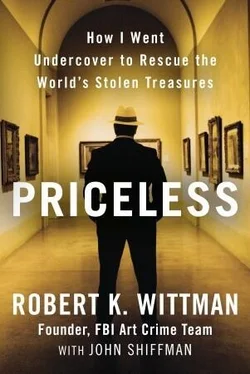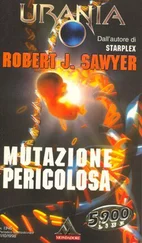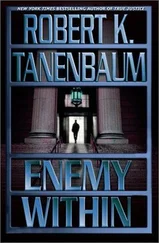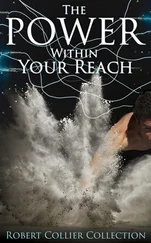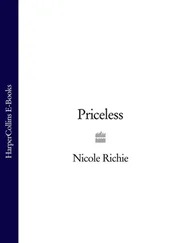Not that Bazin wanted me, or any other rookie. Veteran agents called us “Blue Flamers” because in our first months we were so eager to please that we were said to have blue flames shooting from our asses. Bazin liked to work alone and, at least on the surface, acted as if he couldn’t be bothered to train a neophyte. I suspected he was suspicious of my background. My brief years in the Japanese antiques business with my dad hardly qualified me as an art expert. Worse, most FBI rookies are former cops, soldiers, or state troopers. I was a geeky former ag-journalist. Bazin was a bear of a man, not tall, but burly, and a no-nonsense investigator who’d spent years on the street hunting bank robbers and fugitives. He had an unfailing, enduring loyalty to the FBI and worked diligently on any assignment. That included taking me on.
I settled into an empty desk next to Bazin. The FBI occupied two floors in the central federal building in Philadelphia, part of a redbrick judicial complex two blocks from Independence Hall. The property-theft squad worked in a bullpen in a corner of the eighth floor. On my first day, I went to the supply closet and grabbed a couple of pads, pens, and a handful of blank forms. Bazin patiently watched me arrange them on my desk. When I finished, he caught my eye. “How do you plan to carry all that on the street?”
I didn’t know. “They didn’t tell us at the Academy,” I said lamely.
Bazin growled. “Forget all that shit. The Academy is Disneyland.”
He reached behind his desk, pulled out a weathered tan briefcase, and threw it at me. He told me to fill the case with the essential FBI forms I would need to conduct investigations—forms to execute search warrants, read people their rights, make hidden audio recordings, and seize property.
“Take it with you everywhere you go, every day, every case,” Bazin said. My new partner stood. “C’mon, we’re not going to solve any crimes sitting around here,” he said. “We’ll start after lunch.”
After a couple of hoagies, we drove fifteen blocks to the Rodin Museum. Bazin asked all the questions, and I took detailed notes. We didn’t learn much more than the city police detectives had, and I couldn’t tell what Bazin was thinking as we drove back to the squad room. I wondered—but did not dare ask—why the thief had chosen The Man with the Broken Nose . Perhaps he picked it because it was located so close to the front door. Maybe he was attracted by the sculpture’s shiny nose—for years, curators had allowed museum patrons to rub it for good luck, and the bronze had acquired a bright patina. With few leads to investigate, I tried to make myself useful. I quietly read up on Auguste Rodin and The Man with the Broken Nose , or L’Homme au Nez Cassé .
Mask of the Man with the Broken Nose was Rodin’s first important work, and it is not an overstatement to say that it was revolutionary, as it led him to redefine the world of sculpture, moving it beyond photographic realism, much as fellow Impressionist Claude Monet transformed painting. In many ways, Rodin’s task was tougher. Painters like Monet expressed themselves by deft use of color and light. A sculptor like Rodin worked in monotones on a three-dimensional surface, manipulating light and expression with lumps and creases in plaster and terra-cotta molds. The turning point for Rodin, and indeed for art history, began in 1863, when he was twenty-four, the year his beloved sister died.
Distraught over Maria Rodin’s death, Rodin abandoned his fledgling career as an artist. He turned away from family and friends and toward the church. He even took to calling himself Brother Augustin. Fortunately, a priest recognized that Rodin’s true calling was art, not religion, and he put him to work on church projects. This led to design jobs for Parisian general contractors and the sculptor and painter Albert-Earnest Carrier-Belleuse, known for his sculpture of figures from Greek mythology. On the side, Rodin resumed his own work.
He rented his first studio, a horse stable on the Rue Le Brun, for ten francs a month. The place was raw, one hundred square feet of workspace, a slate floor with a poorly capped well in a corner. “It was ice cold,” he wrote years later, “and penetratingly damp at all seasons of the year.” In a rare photograph from this formative period, Rodin wears a top hat, frock coat, and scraggly goatee, his unkempt hair swept across his ears. He looks confident.
Rodin’s new pieces were not meant to be realistic; they were designed to impart deeper, sometimes multiple meanings. Before his sister’s death, Rodin sculpted people close to him—family, friends, women he dated. Now he turned outward, to sculpt the common man. He was too poor to afford to pay models, and he grabbed volunteers where he could, including the handyman who cleaned his stable-studio three days a week. Rodin described this handyman as “a terribly hideous man with a broken nose.” He was Italian and went by the nickname Bibi, which was the nineteenth-century French equivalent of Mac or Buddy. “At first I could hardly bear to do it, he seemed so dreadful to me. But while I was working, I discovered that his head really had a wonderful shape, that in his own way he was beautiful…. That man taught me many things.”
Rodin worked on the piece on and off for eighteen months. He stored it in the stable, which he could not afford to heat, and covered it only with a damp cloth to keep the terra-cotta from drying out. Rodin’s complex sculpture of a handyman came to resemble a Greek philosopher. It was at once a portrait of an everyman and a superman. It was a portrait of a man and of his times, and a portrait of humanity. It offered a new way for Rodin, a way toward the truth.
Then something extraordinary happened.
One winter night in 1863, the temperature plunged below freezing and the terra-cotta mold froze. The back of its head split off, fell, and shattered. Rodin studied the mask that remained. It seemed to accentuate the creases and the texture of Bibi’s face, his broken nose and the man’s inner agony. The half-finished nature of the work, Rodin concluded, added depth. He had discovered a new form of sculpture, one he would employ again and again.
“The mask determined all my future work,” Rodin recalled. “It was the first good piece of modeling I ever did.”
The Salon was not impressed. The state-sponsored umbrella organization of artists and critics who controlled the most sought-after exhibition space was a conservative crew. In 1864, they were not ready to accept Impressionist art of any kind. Rodin would not necessarily have cared, if the Salon were not so influential, at least economically. The wealthiest buyers, including the Republic of France, were reticent to purchase art not exhibited at the Salon. It would take eleven years before the Salon would accept work by Rodin, Monet, or any of their Impressionist colleagues.
In 1876, Mask of the Man with the Broken Nose made its American debut in Philadelphia, as part of a French exhibition in Fairmount Park celebrating the American centennial, a milestone cultural event that led to the founding of the city’s art museum. For Rodin, the show was a disappointment. He won no prizes, and his work apparently garnered no publicity.
A half century later, an American visionary brought Rodin back to Philadelphia in style.
Jules E. Mastbaum was a self-made movie tycoon who seized on the potential of the cinema-house business in the early 1900s. He turned the moviegoing experience into an entertainment venue that was at once glamorous and accessible. By the early 1920s, as Hollywood began to boom, Mastbaum owned more movie houses than anyone in the United States. Mastbaum named his business the Stanley Company of America in honor of his dead brother, and in scores of midsized cities and towns across America, the local Stanley Theaters, many with grand staircases and lavish decor, became a prime social spot. The most extravagant theater in the chain was built in Philadelphia; it was a 4,717-seat theater with room for a sixty-piece orchestra, a French Empire/Art Deco monstrosity adorned with marble, gold leaf, leaded glass, tapestries, paintings, statues, three balconies, a Wurlitzer organ, and the largest crystal chandelier in the city.
Читать дальше
